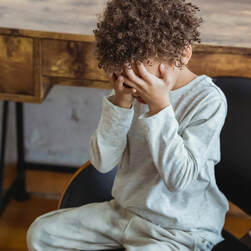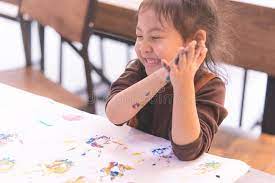|
Even as adults many, if not all of us, have experienced some form of anxiety. Our children are just as susceptible to anxiety but they may not have the skills yet to cope with it.
Anxiety in children can present in a number of ways including: Reassurance seeking Reluctance to separate from parents Physical symptoms such as headache or stomach ache Moodiness/ tantrums Trouble sleeping Teaching proper coping skills will allow them to feel more in control when feelings of uncertainty arise. The goal is not to make the fear go away but to teach them to manage it and to learn to tolerate uncertainty. When techniques for tolerating uncertainty are practiced at home in their “safe place” children will be able to put their skills to work when needed outside the home. As parents we need to be modeling to our children how to react to stressful situations in a healthy way. Instead of thinking worst case scenarios we need to keep ourselves grounded and mindful in the moment. We can manage our own stress and anxiety in a number of ways. Limit the amount of negative content you are taking in. Although it is important to stay informed about the world’s events it can wreak havoc on our own inner peace when we are not careful. Social media can be bad for this, people constantly sharing negative information or “calling each other out” because their opion isn’t aligned with the other persons. Try limiting the amount of time you spend on social platforms that are not filling your cup and limiting the amount of negative articles you are reading each day. Be Present. This a big one in general but especially when it comes to handling anxiety. The actual definition of anxiety is: A feeling of worry, nervousness or unease about something with an uncertain outcome. Since anxiety stems from worry about something that has not yet happened when we focus on being present it is impossible to worry about the future. Consider starting a daily meditation practice to help you on this journey. I absolutely love the Insight Timer App, it has a ton of amazing free guided mediations. Rely on routines. Establishing a routine of daily exercise, getting outside, healthy meals and appropriate amount of sleep is crucial for regulating our moods. So now that we have discussed how to help ourselves let’s talk about how we can help our children. Structure their day. Children thrive on routine and structure (just like we do). When there is certainty in their day such as regular meal times, time for exercise and play, scheduled play dates or classes and a good bedtime routine it will help them deal with the uncertain things that may arise. It is not necessary to schedule their entire day because free down time allows for children to recharge and for their imagination to flourish but having things throughout their day that they can rely on is very important. Acknowledge their emotions and problem solve if you can. What may not be a big deal to you can be a BIG deal to your child. We need to acknowledge how our children are feeling but not allow them to spiral. Work with your child to come up with a plan to help them cope. My daughter recently started kindergarten and knowing that she was getting anxious about so many unknowns coming up. We discussed things that may help her feel at ease and she suggested I go to school with her. Unfortunately with the recent circumstances of COVID that was not an option so instead I called the school and scheduled a quick meeting and tour with her principle. This eliminated many feelings of uncertainty for her because she was able to go into the school with me to see her classroom and meet some of the staff prior to her first day. Initially the school seemed reluctant but after explaining how beneficial it would be to the success of her first day they agreed to meet us. It is important that we advocate for our children to set them up for success, this will in turn empower them to advocate for themselves as well. Avoid over-reassuring. Reassurance can be good in small doses but our children can tend to rely on it and need it more and more. You cannot make promises of a future you yourself do not know about so instead have them practice mindfulness activities at home, in their safe place, with you or on their own so they are better prepared when feelings of anxiety arise. Again I would recommend the Insight Timer App, they have many great children’s mindfulness meditations. Model calm yourself. Your child does not need to hear when you are worried about something; it is not their responsibility to shoulder your burdens. If things are weighing on you, be honest about your own emotions (because we also do not want to teach our children to suppress their emotions) and what you are doing to work through it, ie. going for a walk, mediation, painting or whatever strategies you have adopted to manage your own stress. You have heard the expression “actions speak louder than words” and it is true here too. You can tell your child all you want about how to cope with stressful situations but it will sink in more when they see you demonstrating healthy coping strategies. Look for the positive. I don’t know about you but often when I am stressed I seem to have my sh*t colored glasses on. Nothing is good, everything sucks. When I notice myself getting into this frame of mind I instead start thinking of what I am grateful for. Incorporating a daily gratitude practice with your child can help them focus on the positive things in their life rather than the negative. If you are fortunate enough to eat meals all together as a family you can take turns saying what you are grateful for. Bedtime/wakeups are also a great time to connect and say what we are grateful for so we can start and end the day with positive thoughts. Each night when I am putting my daughter to bed I ask her what her favorite part of her day was, what her least favorite part was (and how it made her feel) and 3 things she is grateful for. I look forward to this time with her because typically I learn something about her day that she hadn’t told me and it is a wonderful time to give her a chance to feel heard. In conclusion we want our children to grow up feeling confident in their own abilities to navigate their world in a healthy way. When we practice healthy coping strategies WITH our children we are giving them the tools to do so. Let’s empower our children to be confident, to see the world in a positive light and to be the best version of themselves. In my opinion the future depends on it.
1 Comment
9/1/2021 0 Comments Process vs Product ArtProcess Art Vs. Product Art
I was teaching at another preschool around Mother’s Day and the children were making their mom’s flower pots to give as their gifts. As I observed the project from the other side of the room where I was teaching I had noticed something that really bothered me. Each flower pot had to be made EXACTLY the same way, there was no creative process or personalization not to mention that after the children left that area to move onto another the teacher in charge of that center was “fixing” their gifts so they were just like the other ones. That is a perfect example of “product art.” Where the project needs to look a certain way otherwise you have not done it correctly. Now don’t get me wrong, there are definitely times when children need to be able to follow directions but in my opinion art should rarely be one of them. Children can become self-conscious of their ability (or lack thereof) to make their art work look how it is supposed to which can cause defiance rather than compliance. The children who are not as capable with their fine motor skills may start acting up to try to avoid doing the project all together. Coming back to the flower pots for a second, would it have been so bad if the children painted what they wanted to on the pots for their mothers? Or perhaps could decide to use the flower pot to make a monster for their mother instead because they knew their mom liked monsters more than flowers. Would that be so bad? As a mother I would much rather have a gift that I know my child made herself with her own creative mind than a cookie cutter gift that looked exactly like all the others. So what is process art and why should you seek out process art activities rather than product art activities especially for younger children? As the name suggests, process art focuses on the process of making the art rather than the outcome. You provide the materials and you let your child (or student) get lost in the experience. You can still tie this type of art into your themes if that is what you would like to do. For example if your theme is leaves and you have read the story Leaf Man, by Lois Ehlert you can set out all the materials to make a leaf man BUT if the child sees something else that they might want to make with the leaves besides what is in the book that is totally ok, it is up to them!! What are the benefits of process art? Independence This type of art will naturally put your child in charge instead of always waiting for direction from you. Overtime they will learn to trust themselves instead of seeking external validation. Confidence Children learn to trust themselves and their own ideas. They will become very proud of themselves and what they have created. Learning Process art can be a great learning experience. Children might need to problem solve if they have a specific plan of what they want to create. They can experiment with different materials by mixing paints, different mediums and the weight of different items they are using to create their projects. Fine and gross motor skills are also practiced here. We want to instill a love of learning at a young age and process art activities can truly do that. There are so many benefits to process art for children of all ages. At Mini MozArts Preschool we believe in child centered learning and process art is one of the many ways we can achieve this. Have you made the switch yet in your home or classroom? |
Archives
May 2023
|



 RSS Feed
RSS Feed